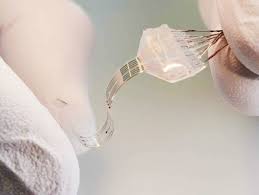HWN Jobs
- PHARMACISTS JOBS AT CAREFORTE PHARMACY
- VATICAN BELLS PHARMACEUTICAL LIMITED JOBS
- GLAXOSMITHKLINE PHARMACEUTICAL LIMITED (NURSES) JOBS
- JAMA ATU NASRIL ISLAM (JNI) MUSLIMS HOSPITAL MANAGEMENT BOARD JOBS
- AFRAB CHEM LTD (2016) JOBS
HWN Blogs
- Classical heart healthy foods on HWN BLOGS
- Classical Warning Signs When The Human Liver Begins To Fail on HWN BLOGS
- Myths About Hygiene, Soaps, Germs, Sweat and Smell on HWN BLOGS
- Hernia does not heal on its own on HWN BLOGS
- Classical Essential Oils That Improves Focus Cum Memory on HWN BLOGS
news - Spinal Implants That Will Help Paralyzed Humans Walk Again, Coming Soon on HWN INSIGHTS back to all News
Spinal Implants That Will Help Paralyzed Humans Walk Again, Coming Soon on HWN INSIGHTS

Spinal implants have suffered similar problems as those in the brain—they tend to abrade tissue, causing inflammation and ultimately rejection by the body. Now an interdisciplinary research collaboration based in Switzerland has made a stretchable implant that appears to solve this problem. Like Lieber's new brain implant, it matches the physical qualities of the tissue where it is embedded.
The “e-dura” implant is made from a silicone rubber that has the same elasticity as dura mater, the protective skin that surrounds the spinal cord and brain, explains Stéphanie Lacour, a professor at the school of engineering at the Swiss Federal Institute of Technology in Lausanne. This feature allows the implant to mimic the movement of the surrounding tissues.
Embedded in the e-dura are electrodes for stimulation and microchannels for drug therapy. Ultrathin gold wires are made with microscopic cracks that allow them to stretch. Also, the electrodes are coated with a special platinum-silicone mixture that is stretchable.
In an experiment that lasted two months, the scientists found that healthy rats with an e-dura spinal implant could walk across a ladder as well as a control group with no implant. Yet rats with a traditional plastic implant (which is flexible but not stretchable) started stumbling and missing rungs a few weeks after surgery. The researchers removed the implants and found that rats with a traditional implant had flattened, damaged spinal cords—but the e-dura implants had left spinal cords intact. Cellular testing also showed a strong immune response to the traditional implant, which was minimal in rats with the e-dura implant.
Finally, the researchers implanted the device directly on the spinal cord of paralyzed rats. With a combination of drug therapy and electrical stimulation administered via the e-dura, the rats were able to walk again. Researchers envision the e-dura being used in people with spinal cord injuries, as a brain implant and even to correct nerve damage in other parts of the body.
Source: Flexible Spinal Implants, HWN Africa.
: 2016-10-27 18:59:31 | : 1382
HWN News
- First Polish infant to survive on extreme dialysis on HWN MEDICAL MIRACLES
- Drug resistant tuberculosis end game on HWN INSIGHTS
- Too many women opting for caesarean sections (CS) to give birth on HWN SEX EDU
- The intelligent, strong and fearless Nurse that conquered Ebola on HWN ARCHIVE
- Medhi Benatia, down with injury on HWN SPORTS






